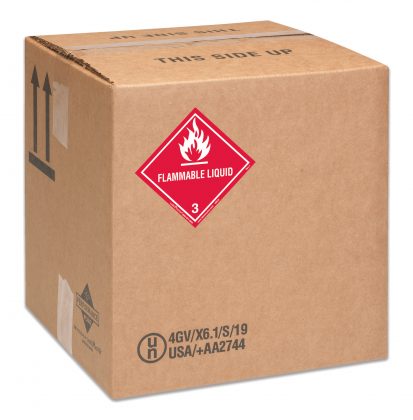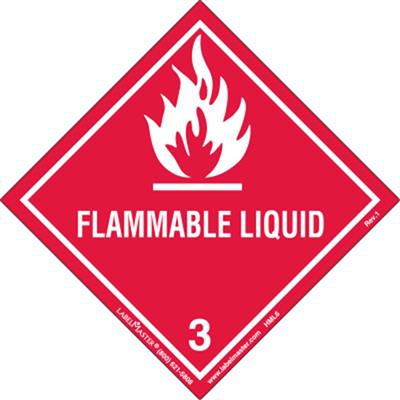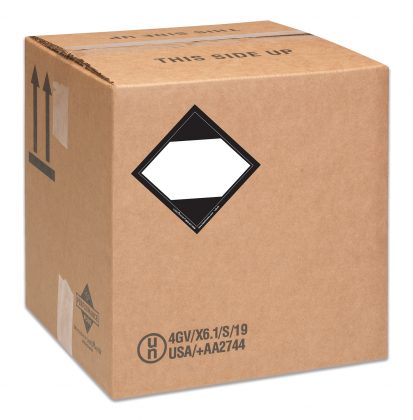Due to the ongoing COVID-19 crisis, supplies of hand sanitizer have been running low at health care facilities for weeks, and the demand is only getting higher. In response, most distillers of alcoholic beverages have switched over some of their production to make desperately needed hand sanitizer.
According to the World Health Organization recommended formula, effective hand sanitizer should be 80% ethanol alcohol (or 75% isopropyl alcohol) by volume, so distilleries are in the perfect position to step up since their operations are already set up to create and handle ethanol. However, hand sanitizer is a completely different hazardous material than the alcoholic beverages these distilleries usually ship. Even though alcoholic beverages and hand sanitizer are both Class 3 flammable liquids, the level of danger assigned to their specific materials can significantly change packaging, marking and labeling requirements. So, it’s important for distilleries to be aware of these differences in order to take the necessary steps to ensure shipments are safe and compliant with the rules and regulations for transporting this specific type of dangerous good.
Variables for Shipping Hand Sanitizer
Alcoholic beverages are Class 3 Flammable Liquids, UN 3065, while hand sanitizers, with different types and concentration of alcohol, are classified differently. They’re still Class 3 Flammable Liquids, but they are typically classified as either Ethanol Solutions, UN 1170 (if Ethanol is the only alcohol used) or Alcohols, N.O.S., UN 1987 (if multiple alcohols are used).
There are a lot of factors that impact the type of hazardous material being shipped. So from a regulatory standpoint it depends on what exactly the distilleries are doing. Here are some of the variables that impact how hand sanitizer can be compliantly shipped:
- What are you actually making? Some distilleries might be converting to make high proof ethanol, then shipping the ethanol to someone else who’s making the hand sanitizer. Others are acquiring all of the other components and compounding the hand sanitizer themselve. The classification of the final product and volume per container must be evaluated to determine packaging and shipping requirements.
- What are you adding? Some hand sanitizers contain isopropyl alcohol (UN 1219) instead of ethanol (UN 1170); some contain both, and can also include small amounts of hydrogen peroxide solution in addition to glycerol and sterile water.
- How much are you shipping, and in what size containers? The current limit for Limited Quantity shipments for flammable liquids assigned to Packing Group III is 5 liters (1.3 gal.) per inner container, and if it’s Packing Group II the per container limit is reduced to 1 liter (0.3 gal.) Although, the Pipeline and Hazardous Materials Safety Administration (PHMSA) is offering temporarily relaxation in expanding that limit to as much as 8 gallons per single container to help facilitate shipping during the COVID-19 emergency. The full PHMSA guidance can be found here.
Limited Quantity shipments require no shipping papers, have less restrictive training requirements, and incur no hazmat surcharges — but packaging your product in smaller containers is more costly than shipping it in larger drums. PHMSA has also provided temporary relief for quantities greater than 8 gallons per package, but has specified procedures that must be followed regarding packaging, labeling, training and more. However, this relief applies for over-the-road transportation and does not apply to shipments by air, vessel or rail.
Labeling Requirements for Shipping Hand Sanitizer
Limited quantity ground shipments of flammable liquids in the United States have minimal packaging requirements and must display the limited quantity mark as well as orientation arrows on two opposing sides of the package (orientation arrows may not be mandatory depending on the size/type of inner container).
If the flammable liquid ground shipments cannot utilize the limited quantity exceptions, then the shipments are fully regulated hazardous materials and must be packaged in certified United Nations (UN) specification packaging, and must display all of the required regulated marks in addition to a Class 3 flammable liquid hazard class label.
FDA’s Recommendations for Temporary Compounding of Hand Sanitizer
Before you ship hand sanitizer, of course, it has to be made properly. In response to the pandemic and the resulting shortage of hand sanitizer, the FDA issued in March 2020 a “Policy for Temporary Compounding of Certain Alcohol-Based Hand Sanitizer Products During the Public Health Emergency.” It contains these nonbinding recommendations for compounding:
- The hand sanitizer is compounded using only the following United States Pharmacopoeia (USP) grade ingredients in the preparation of the product (percentage in final product formulation) consistent with World Health Organization (WHO) recommendations:
- Alcohol (ethanol) (80%, volume/volume (v/v)) in an aqueous solution denatured according to Alcohol and Tobacco Tax and Trade Bureau regulations in 27 CFR part 20; or Isopropyl Alcohol (75%, v/v) in an aqueous solution
- Glycerol (1.45% v/v)
- Hydrogen peroxide (0.125% v/v)
- Sterile distilled water or boiled cold water
- The compounder does not add other active or inactive ingredients. Different or additional ingredients may impact the quality and potency of the product
- The compounder pays particular attention to ensure the ethanol or isopropyl alcohol active ingredient is correct and the correct amount of the active ingredient is used.
- The hand sanitizer is prepared under conditions routinely used by the compounder to compound similar nonsterile drugs.
- The hand sanitizer is labeled consistent with the attached labeling in Appendix A (Labeling for Ethyl Alcohol Formulation Consumer Use), Appendix B (Labeling for Isopropyl Alcohol Formulation Consumer Use), Appendix C (Labeling for Ethyl Alcohol Formulation Health Care Personnel Handrub Use), or Appendix D (Labeling for Isopropyl Alcohol Formulation Health Care Personnel Handrub Use).
Making a Difference Safely and Compliantly
In these unprecedented times, distilleries are just some of the many businesses stepping up to meet the needs of their communities. While their existing operations and infrastructure perfectly position them to manufacture hand sanitizer, it’s important to understand the variables that impact how it should be shipped and take the proper steps to ensure they are packaging, labeling and transporting it safely and compliantly.
If you have any questions about dangerous goods transport, call the Labelmaster Regulatory Hotline at 1.800.621.5808.











